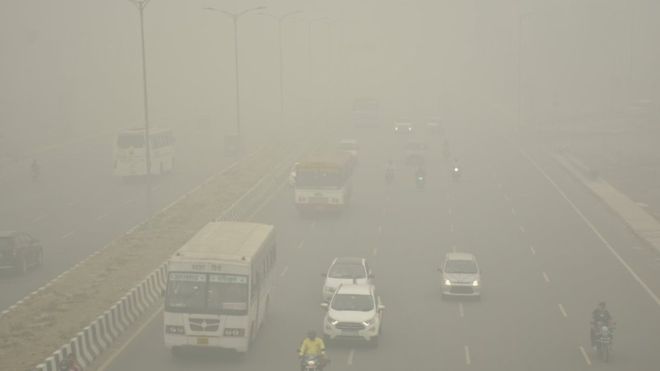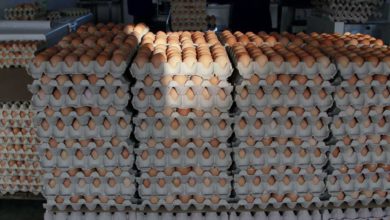
Delhi air quality: Severe pollution drives car rationing
- The Indian capital, Delhi, has launched a car rationing system as it battles hazardous levels of pollution.
The Indian capital, Delhi, has launched a car rationing system as it battles hazardous levels of pollution.
Private cars with even and odd number plates will be allowed on roads only on alternate days from 4 to 15 November, officials said.
The system was introduced in 2016 and 2017 as well, but it’s not clear if it actually helps bring down pollution.
Levels of dangerous particles in the air – known as PM2.5 – are far higher than recommended.
The deteriorating air quality has put millions of people at risk of respiratory illness.
Health officials have asked people to stay indoors and refrain from doing any physical activity. Schools are closed until Tuesday and the shutdown is likely to be extended until Friday as the city continues to choke under a thick blanket of smog.
Delhi Chief Minister Arvind Kejriwal said the car rationing system, known as the “odd-even plan”, would take hundreds of thousands of cars off the road.
Those ignoring the decree will be fined 4,000 rupees (£44; $56), which has doubled from previous years.
Only public transport, emergency vehicles, taxis and two-wheelers will be allowed. Women driving alone will also be exempt from the rule.
But there are doubts that the scheme will do much to ease the smog. Similar measures in the past drastically reduced traffic congestion in Delhi but did not have a significant impact on pollution levels.
What’s caused the pollution?
Experts say emissions from vehicles are just one of several factors that have turned the city into – in Mr Kejriwal’s words – a “gas chamber”.
A major cause of the high pollution levels at this time of year is farmers in neighbouring states burning crop stubble to clear their fields.
This creates a lethal cocktail of particulate matter – carbon dioxide, nitrogen dioxide and sulphur dioxide – all worsened by fireworks set off during the Hindu festival Diwali a week ago.
Construction and industrial emissions have also contributed to the smog.
Identifying the cause has sparked a row between state and federal politicians, with Mr Kejriwal calling on the neighbouring states of Punjab and Haryana to crack down on crop burning.
This led to Federal Environment Minister Prakash Javadekar accusing Mr Kejriwal of politicising the issue and painting his neighbours “as villains”.
But ordinary Indians are just hoping that scattered rainfall over the coming week will wash away the pollutants but this is not due until Thursday.
How bad is the smog?
There is no escaping the oppressive smog which has descended on the city. According to Siddharth Singh, climate policy researcher and author of The Great smog of India, the air in Delhi “smells like burning leaves”.
“It’s smoky. Eyes are itchy. The throat is also a little iffy. And everyone’s feeling it,” he told the BBC.
According to official measurements, the levels of dangerous particles in the air – known as PM2.5 – are far higher than recommended and about seven times higher than in the Chinese capital Beijing, which has battled similar pollution problems in recent years.
An Indian health ministry official said the city’s pollution monitors did not have enough digits to accurately record pollution levels, which he called a “disaster”.
The World Health Organization (WHO) says a third of deaths from stroke, lung cancer and heart disease are due to air pollution.
“This is having an equivalent effect to that of smoking tobacco,” the WHO says on its website.

How does the odd-even plan work?
This is the third time the Delhi government’s “odd-even plan” has been rolled out and it’s been introduced with a few tweaks.
Hundreds of teams from the police, the transport department and civil volunteers have been deployed to enforce the rule. It is likely to put extra pressure on the public transport system.
But officials say they are prepared as extra buses and metro trains will be deployed during this period.
Here’s what you need to know if you are planning on taking out your car in the city:
Private cars with number plates ending in even and odd numbers will be allowed only on alternate days from 4 to 15 November. So, if your number plate ends with one, three, five, seven or nine, you can only drive on odd dates (5,7,9,11,13 and 15) and if it ends in zero, two, four, six or eight, you can drive on even dates (4,6,8,12 and 14).
The restrictions are in place from 8am to 8pm from Monday to Saturday and will also apply to cars coming from outside the city. Sunday is free for all.
Unlike earlier years, vehicles that run on clean fuel like CNG (compressed natural gas) will not be allowed, though electric vehicles are still exempt.
Delhi’s chief minister and other ministers are not exempt, though there is a fairly long list of those who’ve been granted exemptions from the rule:
- All VIPs, including the president, vice-president, prime minister, government ministers, several senior politicians, judges and foreign diplomats
- Women driving alone or with only female passengers. Boys up to 12 are allowed
- Private vehicles with male drivers on the school run or on the way to hospital for medical treatment if they can “prove the emergency”
- Public transport
- All two-wheelers, which include motorbikes and scooters
- Taxis and auto-rickshaws
- Emergency vehicles
- Disabled drivers



